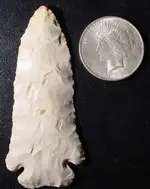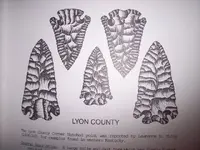Typology is a very fickle thing. Alot of the information in typology books today is very incorrect..or has changed. Even some of the later publications (like perino 3..which is one that contains information about a Lyon County). It takes great devotion and a helluva reference database to try to even remotely get a grip on the most basic of typology.
Jeff, you state "St. Charles or Dovetail". The St. Charles were the first to be named the "dovetail". However, there could be a distinct difference between the true St. Charles and what some consider a true Dovetail. One main thing is that St. Charles aren't always punch notched. Some have much wider notches that are just straight pressure. They also can be, and often are, made with a much flatter cross section than what most consider "Early Archaic Dovetail" - which have a lenticular cross section (like Scottsbluff). I'm sure that time will show that the "St. Charles" is most likely a later form than the 'thick, lenticular, punch notched doves' (Like Ohio Button Base). Here's an interesting side note. Greg Perino once shocked me with a statement he made....he told me that it wouldn't surprise him if the Ohio Button Based Doves weren't a Woodland piece? I questioned him about that statement and don't concur with it at all - primarily due to manufacturing techniques. However, there aren't real definitive dates for them yet and ..who knows. I often disagree with his and others assessments in typology and other realms, from personal experiences and experiments. Sharing of information is how we all learn though.
The earliest Doves appear to be thicker, lenticular and share blade manufacturing techniques with early Hardin and even Scottsbluff. In fact, take just a broken blade from an early dove, early Hardin or a scottsbluff..and let's see you tell them apart. Good luck. The earliest Hardin also didn't bevel..you simply cannot tell them apart from Scottsbluff. In another conversation with Perino, he mentioned to me that Hardin have been found on sites in southern Illinois, that date older than Scottsbluff. It appears that Hardin is an eastern tradition, while Scottsbluff (cody) are the plains counterpart. Compare the dates, the technology. Again, this is diffusion at work. Now, as the Hardin progressed they started a trend of started to get more flat, not quite as lenticular and beveling during the resharpening process became a staple - Just like the St. Charles. Do you see a pattern here?
Sorry, didn't mean to start rambling..uggh, I'll stop now.







